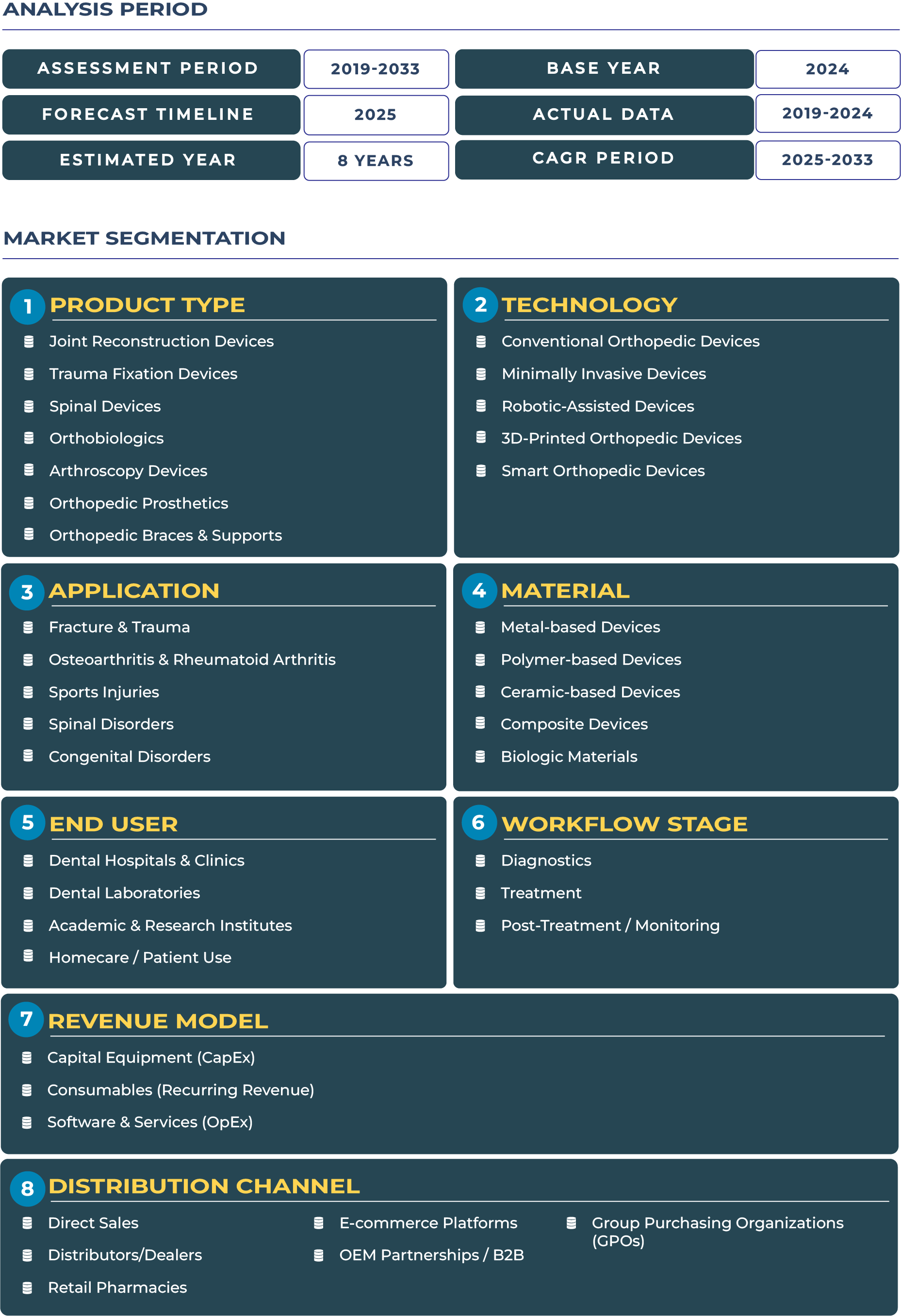Mexico orthopedic devices Market Outlook: Rising as a Hub for Cost-Efficient Care and Medical Tourism
Mexico is increasingly positioning itself as a regional hub for orthopedic procedures, driven by affordability, expanding private healthcare infrastructure, and cross-border medical tourism. Patients from the United States and Latin America are traveling to Mexico for orthopedic surgeries such as hip replacements, knee arthroscopies, and spinal procedures due to competitive pricing and improving quality standards in private hospitals. This trend strengthens the role of orthopedic devices in the Mexican healthcare ecosystem by boosting demand for reliable implants and trauma fixation devices that meet international quality benchmarks.
The Mexico orthopedic devices market is valued at USD 1.22 billion in 2025 and is projected to reach USD 2.34 billion by 2033, growing at a CAGR of 8.5%. This performance is supported by the rising middle class, the expansion of private hospital chains in urban areas such as Mexico City, Monterrey, and Guadalajara, and growing investments in orthobiologics and prosthetic technologies. Furthermore, cost-sensitive yet quality-driven procurement strategies are pushing manufacturers to adapt product lines, including low-cost joint reconstruction devices tailored for the region. Despite challenges such as certification delays and fragmented public-private payer systems, the orthopedic devices industry in Mexico continues to present attractive growth opportunities across the decade.
Expanding Private Healthcare Penetration and Cross-Border Orthopedic Tourism Defining Growth Pathways
Mexico orthopedic devices sector is witnessing transformative shifts driven by private healthcare penetration and medical tourism flows. Rising demand from domestic patients, coupled with inflows from international patients seeking affordable surgeries, is increasing the need for joint replacement implants, spinal devices, and trauma fixation products. The private sector plays a crucial role in bridging gaps left by resource-constrained public hospitals, offering patients faster access to orthopedic procedures and advanced devices.
The country’s healthcare policy landscape also supports growth indirectly by encouraging private investment in medical infrastructure. Economic resilience, despite global geopolitical tensions and the residual effects of the pandemic, is enabling healthcare providers to upgrade operating rooms with arthroscopy devices and adopt next-generation prosthetics. While rural areas remain underserved, urban centers are becoming focal points for device adoption. Mexico’s ability to balance cost-effectiveness with clinical quality positions the orthopedic devices industry as a critical contributor to its evolving healthcare landscape.
Drivers & Restraints: Growth Catalysts and Structural Barriers Shaping Mexico orthopedic devices Sector
Growth in the Mexican orthopedic devices market is being fueled by multiple factors. The expansion of private hospitals, particularly in northern states and major metropolitan regions, is boosting demand for arthroscopy devices and joint reconstruction implants. Mexico’s strategic role as a medical tourism corridor for orthopedic surgeries further amplifies demand, with patients seeking low-cost implants and surgical interventions that align with international standards. Additionally, the ability of manufacturers to offer lower Average Selling Price (ASP) devices tailored to cost-sensitive segments is unlocking significant opportunities in both private and provincial hospital networks.
Yet, the sector faces challenges that temper its growth trajectory. Import tariffs and certification delays slow the entry of advanced devices, limiting patient access to innovative technologies. Fragmented payer systems between public and private sectors lead to inconsistent adoption patterns across provinces. Moreover, rural and underserved regions continue to experience limited device penetration, leaving a gap between urban innovation hubs and provincial hospitals. To overcome these barriers, manufacturers and distributors must streamline logistics, engage early with regulators, and invest in training programs for healthcare professionals across regions.
Trends & Opportunities: Rapid Private Hospital Growth and Localized Strategies Redefining the Orthopedic Devices Landscape in Mexico
One of the defining trends in Mexico orthopedic devices ecosystem is the rapid expansion of private hospital capacity in urban areas. Large chains are scaling their orthopedic departments with a focus on trauma fixation and prosthetic devices to meet rising patient inflows. Cross-border patient flows, particularly from U.S. states such as Texas and California, are expanding the scope of orthopedic tourism, as patients benefit from cost savings of up to 60% compared to U.S. hospitals. Furthermore, consolidation among local distributors is reshaping procurement dynamics, allowing hospitals to access broader orthopedic portfolios through fewer, more integrated partners.
Opportunities are equally compelling. Local manufacturing of low-cost implants is emerging as a priority area, reducing reliance on imports while addressing pricing sensitivity. Total Cost of Ownership (TCO) focused offerings, including bundled device packages, are gaining traction with hospital administrators seeking budget efficiency. Training programs tailored for provincial hospitals also represent a major opportunity, as equipping rural healthcare professionals with expertise in orthopedic device usage can significantly expand market penetration. Together, these opportunities highlight how manufacturers can strategically align with Mexico’s evolving healthcare ecosystem.
Competitive Landscape: Strategic Partnerships and Adaptable Business Models Driving Orthopedic Devices in Mexico
The competitive landscape in Mexico orthopedic devices industry features a mix of multinational leaders and local suppliers navigating unique regulatory and procurement challenges. Global players such as Zimmer Biomet and Stryker maintain strong presence in joint reconstruction and spinal devices, while local distributors bridge the gap for trauma fixation and orthobiologics.
Strategic approaches increasingly revolve around partnering with national distributors to navigate certification processes and logistics efficiently. Manufacturers are introducing low-cost implant lines to serve the cost-sensitive private market, particularly in prosthetics and trauma fixation. Training hubs in cities like Mexico City and Monterrey are being developed to support orthopedic surgeons in adopting new arthroscopy devices and prosthetic solutions. Furthermore, outcome-based pilot programs initiated in 2024 emphasized procurement models that reward clinical effectiveness, positioning companies that can demonstrate value through data collection at an advantage in provincial tenders.







